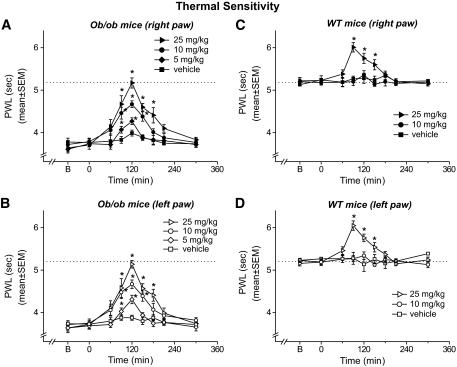FIG. 5.
ECN, a selective T-channel blocker and neuroactive steroid, induced greater dose-dependent alleviation of heat hypersensitivity in ob/ob mice (A and B) than in wild-type mice (C and D). For all dose-response experiments, 10- to 12-week-old mice (at the peak of thermal hypersensitivity) were used. ECN (5 mg/kg i.p.) caused small but significant increases in PWLs in right (A) and left paws (B) of ob/ob mice, with the peak effect at 120 min after injection (*P < 0.001). When 10 mg/kg of ECN was administered, the peak effect still occurred at 120 min but lasted longer; that is, the increase in PWLs was still significant at 150 min compared with those at 0 min (immediately before the injection) (*P < 0.001) in both right (A) and left paws (B). Injection of 25 mg/kg of ECN caused a profound increase in PWLs that remained significant 180 min after injection (*P < 0.001). At the peak effect, the highest dose of ECN caused complete reversal of mechanical hypersensitivity; that is, PWLs were similar to the baseline PWLs recorded in wild-type mice (dotted line). When ECN was administered to wild-type mice at 10 mg/kg, a dose that was effective in ob/ob mice, there was no effect on PWLs at any time in either right (C) or left paws (D); that is, PWLs remained at the baseline level (dotted line). Only at 25 mg/kg did ECN cause a significant increase in PWLs in wild-type mice, with a peak effect at 90 min. However, this effect was not as robust as that in ob/ob mice (*P < 0.001) (n = 6 ob/ob mice per group; n = 6 wild-type mice per group). WT, wild type.

